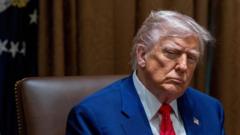After a dramatic week, Donald Trump's ambitious tariff plan has met resistance, leading to a temporary suspension of higher tariffs on most countries for 90 days. This pause has immediate implications for the administration's objectives in trade relationships, particularly with China.
1) **Better Trade Deals**
Trump asserted, “For decades, our country has been looted, pillaged, and plundered,” positioning tariffs as a tool to negotiate better trade agreements. The initial proposal, involving a flat 10% tariff on nearly all imports and additional tariffs on the perceived worst offenders, startled global leaders. Notably, negotiations with Japan and South Korea are underway, with many countries seeking to appease the U.S. as a deadline looms in 90 days. The outcome of these discussions could significantly shape future U.S. trade policy.
2) **Boosting American Industry**
With a vision to revive U.S. manufacturing, Trump has long touted tariffs as a means to protect and grow the domestic industrial sector. However, the unpredictability of tariff fluctuations raises doubts among businesses contemplating reinvestment in U.S. manufacturing. Enterprises are likely to hesitate before committing to new factories, awaiting clearer guidelines from the administration.
3) **Confronting China**
Trump's rhetoric has turned especially critical of China, accusing them of exploiting the U.S. economy. Though the administration aims to position Trump’s confrontation with China as necessary, there's acknowledgment of the risks involved in escalating tensions with such a substantial economic force. The administration’s mixed messages may alienate essential allies needed in this confrontation.
4) **Raising Revenue**
Trump anticipates that tariffs will generate substantial revenue, suggesting it could aid in lowering taxes and addressing the federal deficit. A projection indicated a potential revenue increase of $2 trillion over a decade from a 10% tariff. Nonetheless, fluctuations in productions and imports could alter this projected financial influx.
5) **Consumer Prices**
Although lower domestic production is touted as a means to reduce consumer costs, the reality may differ. Existing studies predict that these tariffs could increase household expenses significantly. Most concerning is the potential burden on lower-income families, who may feel the brunt of price hikes as tariffs are applied.
As Trump navigates these intricate trade negotiations, the effects of his tariff strategies on the economy and international relationships loom large. The implications of this trade policy, especially concerning consumer prices and alliances, warrant careful consideration from both the administration and the American public.
1) **Better Trade Deals**
Trump asserted, “For decades, our country has been looted, pillaged, and plundered,” positioning tariffs as a tool to negotiate better trade agreements. The initial proposal, involving a flat 10% tariff on nearly all imports and additional tariffs on the perceived worst offenders, startled global leaders. Notably, negotiations with Japan and South Korea are underway, with many countries seeking to appease the U.S. as a deadline looms in 90 days. The outcome of these discussions could significantly shape future U.S. trade policy.
2) **Boosting American Industry**
With a vision to revive U.S. manufacturing, Trump has long touted tariffs as a means to protect and grow the domestic industrial sector. However, the unpredictability of tariff fluctuations raises doubts among businesses contemplating reinvestment in U.S. manufacturing. Enterprises are likely to hesitate before committing to new factories, awaiting clearer guidelines from the administration.
3) **Confronting China**
Trump's rhetoric has turned especially critical of China, accusing them of exploiting the U.S. economy. Though the administration aims to position Trump’s confrontation with China as necessary, there's acknowledgment of the risks involved in escalating tensions with such a substantial economic force. The administration’s mixed messages may alienate essential allies needed in this confrontation.
4) **Raising Revenue**
Trump anticipates that tariffs will generate substantial revenue, suggesting it could aid in lowering taxes and addressing the federal deficit. A projection indicated a potential revenue increase of $2 trillion over a decade from a 10% tariff. Nonetheless, fluctuations in productions and imports could alter this projected financial influx.
5) **Consumer Prices**
Although lower domestic production is touted as a means to reduce consumer costs, the reality may differ. Existing studies predict that these tariffs could increase household expenses significantly. Most concerning is the potential burden on lower-income families, who may feel the brunt of price hikes as tariffs are applied.
As Trump navigates these intricate trade negotiations, the effects of his tariff strategies on the economy and international relationships loom large. The implications of this trade policy, especially concerning consumer prices and alliances, warrant careful consideration from both the administration and the American public.




















